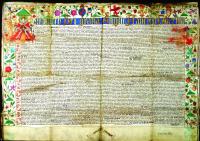Jettisoning faith, culture and identity to serve the Crown: Elizabethan grant of land and title to Florence Fitzpatrick, 3rd baron of Upper Ossory, 1581
Published in Early Modern History (1500–1700), Features, Gaelic Ireland, Issue 3 (May/June 2011), Volume 19 Painstakingly hand-painted on almost three square metres of vellum, the Fitzpatrick manuscript is written in Latin and decorated with ornate depictions of English fruits, flowers, insects and woodland creatures, redolent of Tudor propaganda depicting a providential reign, in harmony with nature, God and the English people.
Painstakingly hand-painted on almost three square metres of vellum, the Fitzpatrick manuscript is written in Latin and decorated with ornate depictions of English fruits, flowers, insects and woodland creatures, redolent of Tudor propaganda depicting a providential reign, in harmony with nature, God and the English people.
The evolution of the Fitzpatrick dynasty, hereditary lords of Upper Ossory, during the second half of the sixteenth century serves as a remarkable example of the fluidity of ethnic identity among the Gaelic landowning élite when faced with the determination of the Tudor Crown to ‘make Ireland British’. Under the terms of the Crown’s surrender and regrant policy, the Irish chiefs were given the opportunity to retain their ancient privileges, albeit as vassals in a scrupulously English aristocracy, and were expected to submit to, and relentlessly promote, English culture and conventions, as part of a larger attempt at ‘civilising’ the Irish.
Gaelic chieftain Brian MacGiolla Phádraig of Upper Ossory, a Gaelic kingdom comprising parts of modern-day Kilkenny and south Laois, was the first Gaelic noble to abandon his native title, in the process taking the Anglicised name Barnaby Fitzpatrick, in 1541. As a demonstration of his loyalty to the English Crown, he sent his son, also named Barnaby, to the royal court in 1543; bizarrely for the son of an obscure Gaelic chief, the young Barnaby subsequently become one of King Edward’s nine official ‘henchmen’, the most intimate circle of youths attendant on the king—even serving as his official ‘whipping boy’, liable to the physical beatings that the king’s tutors would have inflicted upon Edward but for his royal personage.
Barnaby subsequently returned to Ireland to help impose English rule on his Gaelic kin and served as protector of the New English planters in the midlands, quelling the rebellion of the native Irish clans of O’More and O’Connor in 1563–4, despite his father’s kinsmen fighting alongside his Gaelic co-religionists. In addition to quelling unrest among the Gaelic chiefs, however, low-level warfare simultaneously broke out between the ‘upstart’ Fitzpatricks and the powerful Norman dynasty the Butlers of Ormond. The Butlers had long been one of the leading Old English ruling families in Ireland and resented the favour and newly acquired prestige of the previously obscure MacGiolla Phádraigs. To complicate matters further, Barnaby Fitzpatrick and the head of the Butler family, Thomas Butler, 10th earl of Ormond, were first cousins and had been reared together at the English royal court. Resentful of his social eclipse by his cousin and determined to put his traditional inferior in his place, Butler kidnapped his cousin’s wife and son in 1571, forcing Barnaby to pay a large ransom.
Caught between the intrigues of their old clansmen among the Gaelic chiefs, the advances and confiscations of powerful New English settlers, and the power and prestige of the old Norman families, the kingdom of Upper Ossory formed a natural fault line and theatre of military operations in late sixteenth-century Ireland. The evolution of the Fitzpatricks’ political, religious and ethnic identity reflected their determination to enhance their power and prestige within the increasingly complex network of rival ethnic and political allegiances, and their adoption of English standards of ‘civilisation’ became a common survival tactic for other Gaelic families.
Their attainment of royal patronage, however, enshrined in this manuscript, came at a high price, and Barnaby died in isolation and ignominy following a spell of imprisonment imposed by the very same government for which he had jettisoned his faith, culture and identity. Distrusted by the English court after King Edward’s death, resented as a social inferior by the Norman élite at home and held in deep disdain as a traitor by his old kin among the Gaelic chiefs, Barnaby Fitzpatrick—whipping boy, henchman, soldier and chief—died as a collaborator in the eyes of the Irish in 1581.
A high-resolution image of this parchment is available, along with images of all the manuscripts featured in this series, on the National Library of Ireland’s flickr website, www.flickr.com/photos/ nlireland. HI
















